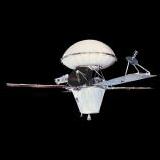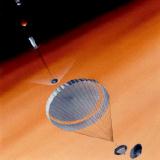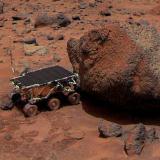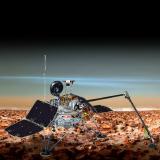 |
||||||||||||||
|
Sojourner explores Yogi.
|
||||||||||||||
| THE EXPLORATION OF MARS | ||||||||||||||
| The view that Mars was a fertile planet supporting alien life changed dramatically in July 1965 when Mariner 4 flew past the planet and returned 22 pictures. The pictures were of low contrast, but revealed heavy impact cratering and a surface disappointingly like our Moon. Many of the spacecraft launched by the Russians and the Americans either failed at launch or during the long journey. Visits by Mariner 6 and Mariner 7, although returning better pictures, did little to change the view of Mars as a dull moon-like planet. | ||||||||||||||
| Mariner 9 | ||||||||||||||
| The Americans launched two further spacecraft in 1971: Mariner 8 and Mariner 9. Mariner 8 dived into the Atlantic Ocean after the failure of the launch rocket. Mariner 9, however, not only left the Earth, but arrived at Mars in full working condition, however its first images revealed a blank planet. A global Martian dust storm was in progress and nothing could be seen. At this time Russia's Mars 2 and Mars 3 orbiters arrived and were also prevented by the dust storm from capturing any surface details. Mars was becoming unrewarding. Unlike Russia's Mars 2 and Mars 3 orbiters, Mariner 9 was programmable and would accept commands sent to it from Earth. The Mars 2 and Mars 3 orbiters were pre-programmed, and on arrival at Mars took many pictures that showed nothing, until eventually their batteries ran out of energy. Mariner 9, meanwhile, had been ordered to wait quietly in orbit, not wasting precious energy, until the storm was finished. Two weeks after its arrival the dust storm cleared, and the new Mariner 9 pictures showed a Martian surface that was completely unexpected. Mariner 9 found volcanoes, canyons, and fracture networks, all of a size never seen before. And most remarkably there were signs of water erosion, tributaries, and rivers. Suddenly Mars was fascinating again. | ||||||||||||||
 Mariner 9. |
||||||||||||||
| Russian Missions | ||||||||||||||
| The Russians continued with their attempts to explore Mars, with some success. Mars 4 reached Mars, but then failed and flew past without doing anything. Mars 5 however acquired dozens of images similar to the American Mariner 9 mission. Although Mars 6 most likely achieved a soft landing on the Martian surface, all contact with the spacecraft was lost. Mars 7, another lander, actually missed Mars completely. | ||||||||||||||
| The Viking Missions | ||||||||||||||
| The results from Mariner 9 changed the perception of Mars, however it was the two highly successful Viking missions that returned most information from the planet. The Viking Project consisted of two spacecraft, Viking 1 and Viking 2, with each spacecraft consisting of a lander and an orbiter. The aim of the mission was to acquire complete coverage of Mars with high resolution images, study the chemistry and behaviour of the atmosphere, analyse Martian soil, and perform some experiments to search for signs of life. | ||||||||||||||
| Viking Orbiters | ||||||||||||||
| Viking Orbiter 1 spent the first month of its mission taking pictures in order to check that the chosen landing site were safe. The original aim was for Lander 1 to touchdown on the 4th July, American Independence Day, but the pictures being returned showed that the original landing sites were unsafe. Once the Landers had detached from the Orbiters and made a safe touchdown, the Orbiters continued with their primary mission of mapping the planet. The two Orbiters had a very successful mission, achieving over 2,000 orbits between them and obtaining over 51,000 high quality pictures. Flying in a low orbit, sometimes only 300 kilometres above the surface, the Orbiters provided a wealth of visual material that revealed a huge variety of surface features. With image resolutions between 150 and 300 metres, and in some areas as good as 8 metres, the Orbiters have provided the most complete information we have about Mars. The interactive Mars globe used in this software is built from these Viking Orbiter images. | ||||||||||||||
|
||||||||||||||
| Viking Landers | ||||||||||||||
| The two Landers also had a highly successful mission. They provided over 1,400 images of the surface, and made temperature, pressure and wind speed measurements. The long-term reliability of the Landers meant that they recorded seasonal changes in their measurements. Each Lander was equipped with a scoop, allowing it to collect samples of Martian soil and place them in an on-board laboratory. The laboratory analysed the chemistry of the soil, performing experiments to see if the soil contained any microbes. | ||||||||||||||
|
||||||||||||||
| Phobos 1 and 2 | ||||||||||||||
| The two Phobos missions were Russian attempts to both study and land on Phobos. Each probe was equipped with a lander and a "hopper" that was designed to descend to the surface of Phobos. The lander would remain in one place, while the hopper would jump from one location to another. Although Phobos 2 managed to achieve part of the planned mission by studying Mars, both the Phobos craft failed to deliver their landers to Phobos. | ||||||||||||||
| Mars Observer | ||||||||||||||
| Mars Observer was intended to study the surface and climate of Mars, as well as measure the magnetic field and explore the behaviour and circulation of the atmosphere. After an uneventful journey to Mars, all contact was lost just three days before Mars Observer was scheduled to enter into Mars orbit. At the time there was speculation that Mars Observer had been destroyed by Martians. | ||||||||||||||
| Mars 96 | ||||||||||||||
| The Russian Mars 96 spacecraft was launched into Earth orbit, but then failed to start its long journey to Mars. The spacecraft orbit decayed and Mars 96 eventually plunged back into Earth's atmosphere, probably landing in the Pacific Ocean. | ||||||||||||||
| Mars Pathfinder | ||||||||||||||
| The Mars Pathfinder mission consisted of a stationary lander and a mobile surface rover. The main aim of the mission was to demonstrate and test low-cost technology for the exploration of the Martian surface. Pathfinder landed in the Ares Vallis region a large outflow channel near Chryse Planitia. | ||||||||||||||
 Mars Pathfinder. |
 Mars Pathfinder. |
|||||||||||||
| Sojourner | ||||||||||||||
| The Sojourner rover was controlled by an Earth-based operator, with the help of images obtained by both the rover and the lander. The delay (of about 10 minutes) in sending images to Earth made navigation difficult, but Sojourner was fitted with an automatic hazard avoidance system. | ||||||||||||||
| Sojourner relied on its own electrical power, its solar panel providing enough energy for it to operate for a few hours each day. As well as cameras, Sojourner also carried an alpha-proton-X-ray spectrometer used to determine the chemical characteristics of the surrounding rocks and soil. Images of all the samples tested were transmitted via the lander to Earth. Surface operations were completed during the first seven days. During this period, Sojourner made journeys to large rocks seen by the lander, and pictures of Sojourner's tracks in the Martian soil provided information regarding the soil's physical characteristics. Sojourner also took pictures of the lander in order to provide evidence of the lander's resilience to the impact and subsequent bouncing across the surface. The mission ended on 27th September 1997, when communication was lost. Pathfinder was renamed the Sagan Memorial Station, in memory of the late Carl Sagan, astronomer and populariser of science. | ||||||||||||||
 Sojourner. |
||||||||||||||
| Mars Global Surveyor | ||||||||||||||
| The American Mars Global Surveyor (MGS), launched in November 1996, has returned massive quantities of valuable data, the most impressive being the high resolution images of the surface revealing an amazing variety of landforms too small to be seen in the Viking pictures. Mars Global Surveyor has also returned information about Mars' gravity, magnetic field, atmosphere and weather, and provided a much more detailed surface height map of the planet. The primary mission ended in January 2001, but operations were extended through 2003. MGS has a secondary role- to act as a communications relay for other spacecraft. MGS is the start of a major, ten-year programme of Mars exploration that will involve new orbiters and landers being launched every two years. | ||||||||||||||
| Nozomi | ||||||||||||||
| Nozomi is a Japanese spacecraft that will study the upper atmosphere of Mars. Launched on 3rd July 1998, the original intention was for Nozomi to arrive at Mars in 1999. Unfortunately, engine firings to correct the flightpath used up too much fuel. In order to conserve energy Nozomi is now travelling more slowly to Mars, with arrival expected in December 2003. | ||||||||||||||
 Nozomi. |
||||||||||||||
| Mars Polar Lander | ||||||||||||||
| Polar Lander, launched in January 1999, was lost during the final descent to Mars' surface on the 3rd December 1999 when controllers were unable to establish contact with the craft. The lander was to put down near the edge of the northern ice cap and monitor the local weather (temperature, pressure, wind speeds) and study frost, ground ice, fog, haze and dust. It was to analyse polar soil for water and carbon dioxide content and record sound on the Martian surface. Searches using new images of the area, returned by the orbiting MGS, failed to locate Polar Lander. | ||||||||||||||
| Mars Climate Orbiter | ||||||||||||||
| The Mars Surveyor 98 programme consisted of two spacecraft: the Mars Climate Orbiter, and the Mars Polar Lander. The missions were intended to study the daily Martian weather and climate, and the quantities of water and carbon dioxide. They were to monitor the amount of dust in the atmosphere, atmospheric water vapour concentrations and measure atmospheric temperatures. The spacecraft was also intended to search for evidence of long-term climate change. Mars Climate Orbiter was launched successfully on the 11th December 1998 however the spacecraft failed to enter Mars orbit as planned on the 23rd September 1999. | ||||||||||||||
 Mars Climate Orbiter. |
||||||||||||||
| Mars Odyssey | ||||||||||||||
| NASA's 2001 Mars Odyssey was launched on the April 7th, 2001, and arrived at Mars on October 24th, 2001. Its main mission through 2002 and 2004 is to map the chemical composition across the surface and look for hydrogen, as part of water ice, just below the surface. Another of Odyssey's goals is to explore the radiation environment in low Mars orbit, and determine the level of radiation-related risk to future human explorers. After the science mission has ended, Odyssey (like MGS) will remain in orbit and provide a communications relay for the next spacecraft to reach Mars' surface - the Mars Exploration Rovers to be launched in 2003. | ||||||||||||||
| Mars Express | ||||||||||||||
| Launched in 2003, Mars Express is Europe's Mars Mission. Mars Express' main objectives are to survey Mars from orbit looking for water below the surface using Radar, return images and data which will help better our understanding of the Martian weather, and provide 3D surface mapping to improve our knowledge of Mars' structure and geology. Mars Express also carries a small lander. The lander was named Beagle 2, after the ship in which Charles Darwin made his voyages of natural history discovery. Beagle was launched successfully but failed to send a signal after landing and was never located on the surface. | ||||||||||||||
| Mars Exploration Rover | ||||||||||||||
| The Mars Exploration Rover mission, launched in 2003, comprises a pair of robotic vehicles similar to Sojourner. The landing sites are Gusev Crater, which may have once held a water lake, and Meridiani Planum a region dominated by grey haematite (an iron oxide material) usually formed in the presence of water. Both these sites may have once provided habitats for simple life-forms. The rovers travelled seperately, Mars Exploration Rover 'Spirit' landing on 3 January 2004, followed by its twin - 'Opportunity', on 25 January 2004. Since landing, both rovers have continued to send back valuable data and images. | ||||||||||||||
| The Future | ||||||||||||||
| Over the last few years NASA has drawn up more detailed plans for the long-term exploration of Mars. The planning of these missions naturally takes advantage of the recent expansion in our knowledge of Mars' surface, but also learns lessons from mission failures. Among the missions being considered are a Mars Reconnaissance Orbiter- launching in 2005, Scout missions- the first for launch in 2007, a Smart Lander and Long Range Rover- for launch in 2009, and perhaps most ambitious of all, a sample return mission- for launch in 2014. | ||||||||||||||
| The Mars Reconnaissance Orbiter, would carry a 'sounder' to look for water, and cameras able to take very close-up pictures of the surface, in which objects just 30 centimetres across could be picked out. Such incredibly detailed pictures would be of tremendous scientific value and would help find sites free of rocky debris dangerous to future landing sites for future exploration. | ||||||||||||||
| The Smart Lander and Long-range Rover. The rover component of the mission- a mobile science laboratory- would use a sophisticated hazard avoidance system to explore and collect data from interesting sites. The rover would be able to travel further from the lander than recently possible and negotiate more difficult terrain. | ||||||||||||||
| Scout Missions are relatively low-cost 'mini-missions' which would involve the use of aircraft on Mars for remote sensing operations. Either balloons, or aeroplanes could be used for detailed studies of planet's surface and collect atmospheric and meteorological data. | ||||||||||||||
| Plans to return samples of Mars' rock and soil are in the the very early stages of development. A sample return mission, involving the participation of various space agencies, would deliver highly sophisticated miniature drilling equipment to the Martian surface and a vehicle for putting samples in orbit for collection and return to Earth. | ||||||||||||||
|
|
||||||||||||||